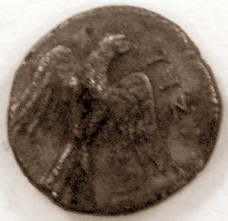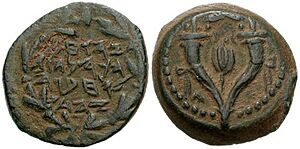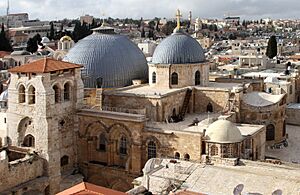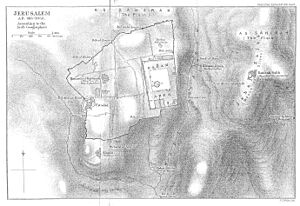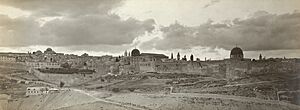History of Jerusalem facts for kids
Jerusalem is an ancient city with a very long and exciting history. It has been attacked 52 times, captured 44 times, and even destroyed twice! People first settled here around 4000 BCE, making it one of the oldest cities in the world where people have continuously lived. Jerusalem is incredibly important to three major religions: Judaism, Christianity, and Islam. Because of this, many different groups have wanted to control it throughout history.
Contents
Ancient Times in Jerusalem
Early Settlements and Names
Archaeologists believe the first people settled near the Gihon Spring between 3000 and 2800 BCE. This spring was a vital water source. The city was first mentioned around 2000 BCE in ancient Egyptian writings called the Execration Texts. They called the city Rusalimum. The name might mean "peace" or refer to Shalim, an ancient god.
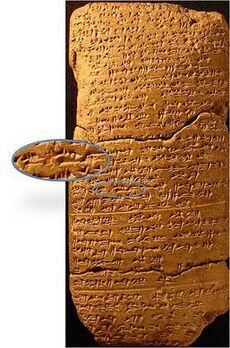
Canaanites and Egyptians
By the 17th century BCE, the Canaanites built huge walls around Jerusalem. These walls were made of giant boulders, weighing 4 to 5 tons each, and stood 26 feet high! They protected the city's important water system.
Around 1550–1400 BCE, Jerusalem became a smaller kingdom under the control of the powerful New Kingdom of Egypt. Letters from this time, called the Amarna letters, show that a leader named Abdi-Heba ruled Urusalim (Jerusalem) and reported to the Egyptian pharaoh.
Egyptian power in the region started to fade around the 12th century BCE. This was part of a bigger event called the Bronze Age collapse, which saw many powerful empires weaken. This allowed smaller, independent kingdoms to grow. According to the Bible, Jerusalem was then known as Jebus and its people were called Jebusites.
The Israelite Period
According to the Bible, the Israelite history of Jerusalem began around 1000 BCE. King David captured the city and made it the capital of the United Kingdom of Israel. It became known as the City of David.
The Bible says that King David's son, Solomon, built a magnificent temple in Jerusalem. This was the Temple of Solomon, a very important religious center. Over time, this temple became the main place of worship for the Israelites. Archaeologists are still debating if the biblical stories are fully supported by what they find in the ground.
When the larger Kingdom of Israel split, Jerusalem became the capital of the southern Kingdom of Judah. This kingdom lasted for about 400 years.
Assyrian and Babylonian Control
Jerusalem faced many challenges from powerful empires. In 701 BCE, the Assyrian king Sennacherib tried to capture Jerusalem. The city survived this attack, unlike the capital of the northern Kingdom of Israel, which had fallen earlier.
Later, in 597 BCE, the Babylonians conquered Jerusalem. They took the young King Jehoiachin and many important people to Babylon. The Babylonians then put Zedekiah on the throne. But when Zedekiah rebelled, the Babylonian king Nebuchadnezzar returned in 587/586 BCE. He recaptured the city, destroyed the temple, and tore down the city walls. Many more people were taken captive to Babylon.
Persian Rule
After several decades, the Persians conquered Babylonia. According to the Bible, the Persian king Cyrus the Great allowed the Jews to return to Judah and rebuild their temple. The Second Temple was finished in 516 BCE. Later, Artaxerxes I sent Ezra and Nehemiah to rebuild Jerusalem's walls and govern the area.
Classical Antiquity
Greek Influence
When Alexander the Great conquered the Persian Empire, Jerusalem came under Greek control. After Alexander's death, his generals fought over his empire. Jerusalem first fell under the Ptolemaic (Egyptian Greek) rule, then later under the Seleucid (Syrian Greek) rule.
Many Jews adopted Greek customs, a process called Hellenization. This led to a rebellion in the 160s BCE by a family called the Maccabees. Led by Judas Maccabeus, they captured Jerusalem in 164 BCE and restored Jewish worship in the Temple. This event is still celebrated today in the Jewish festival of Hanukkah.
Hasmonean Kingdom
The Maccabean Revolt led to the creation of an independent Jewish state called the Hasmonean Kingdom. Jerusalem became its capital. This kingdom expanded its borders and even minted its own coins. However, arguments among the Hasmonean rulers eventually led to the Romans getting involved.
Early Roman Period
In 37 BCE, Herod the Great captured Jerusalem and became a client-king for the Romans. Herod was a great builder. He rebuilt the Second Temple, making it much larger and more magnificent. People said that "He who has not seen the Temple of Herod has never seen a beautiful building in his life."
Jerusalem became the birthplace of Early Christianity. The New Testament describes it as the place where Jesus was crucified, resurrected, and ascended to heaven. It was also where Jesus's followers received the Holy Spirit at Pentecost and began spreading their message. Jerusalem became an important early center for Christians.
By the end of this period, Jerusalem was very large, with about 70,000 to 100,000 people living there.
Jewish–Roman Wars
In 66 CE, the Jewish people in the Roman province of Judea rebelled against the Roman Empire. This was called the First Jewish–Roman War. Jerusalem became the center of the rebellion. After a difficult five-month siege, Roman armies led by Titus conquered and destroyed much of Jerusalem in 70 CE. The Second Temple was burned, and only its outer walls remained, including what is now known as the Western Wall.
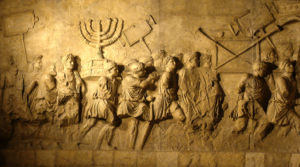
Later, the Romans rebuilt Jerusalem as a Roman colony called Aelia Capitolina. Jews were forbidden from entering the city. This led to another major rebellion in 132 CE, the Bar Kokhba revolt. The Jews briefly gained independence, but the Romans crushed the revolt. Many Jews were killed, and they were expelled from the Jerusalem area. They were only allowed to enter the city once a year, on a day of mourning for the Temple's destruction.
Later Ancient Times
Late Roman Period
Aelia Capitolina was a typical Roman town with temples to Roman gods. It had no walls and was protected by a small Roman army. For about 200 years, it remained a relatively unimportant Roman town. Roman citizens and soldiers settled in the areas around the city. Jews were still banned from the city.
Byzantine Period
When the Roman Empire became Christian, Jerusalem grew as a center for Christian worship. Constantine the Great's mother, Helena, visited Jerusalem in the 4th century. She identified the site of Jesus's crucifixion and burial, where the Church of the Holy Sepulchre was built. This church was dedicated in 335 CE.
In the early 7th century, the Persians attacked Jerusalem. With help from Jews, they captured the city in 614 CE. Byzantine records say the Persians and Jews killed many Christians and destroyed churches, including the Church of the Holy Sepulchre. The Persians held the city for about 15 years until the Byzantine emperor Heraclius recaptured it in 629 CE.
Medieval Period
Early Muslim Rule
Jerusalem was one of the first cities captured by the Arab Caliphate in 638 CE. According to historians, the Caliph Umar ibn al-Khattab himself came to accept the city's surrender. He allowed Jews to return to the city after centuries of being banned.
Under early Muslim rule, especially the Umayyad dynasty (650–750 CE), Jerusalem thrived. The famous Dome of the Rock was built on the Temple Mount around 691–692 CE. It's a shrine that protects the Foundation Stone. The Al-Aqsa Mosque was also built nearby. These buildings made the Temple Mount a very important Islamic site.
During this time, Jerusalem was known for its fertile land. However, it was not as politically or culturally important as other major Muslim capitals like Damascus or Cairo.
Fatimid and Seljuk Periods
In the early 11th century, the Egyptian Fatimid Caliph Al-Hakim bi-Amr Allah ordered the destruction of all churches. Later, an earthquake in 1033 severely damaged the Al-Aqsa Mosque, but it was rebuilt.
In 1071, Jerusalem was captured by the Seljuk Turks, who were Sunni Muslims. They were not friendly with the Fatimids or many Shia Muslims. This led to instability and riots. The Seljuks also made it difficult for Christian pilgrims to visit. In 1098, the Fatimids recaptured Jerusalem from the Seljuks.
Crusader and Ayyubid Periods
The Fatimid control of Jerusalem ended when Crusaders from Europe captured the city in July 1099. The capture was very violent, with many Muslim and Jewish inhabitants killed. Jerusalem became the capital of the Kingdom of Jerusalem. The Crusaders rebuilt the Church of the Holy Sepulchre and converted Muslim shrines on the Temple Mount for Christian use. Military orders like the Knights Hospitaller and Knights Templar were formed to protect pilgrims.
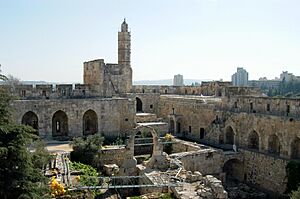
In 1187, the famous Muslim leader Saladin recaptured Jerusalem after the Siege of Jerusalem. He allowed people of all religions to worship freely. In 1219, the city walls were torn down by an Ayyubid sultan, making Jerusalem defenseless. The city changed hands several times between Christians and Muslims in the following decades.
Mamluk Rule
From 1260 to 1516, Jerusalem was ruled by the Mamluks, who were based in Egypt. The Mamluks built many new structures in Jerusalem, especially around the Temple Mount. These included schools, hospitals, markets, and fountains. This period saw a lot of construction and development in the city.
Jewish communities were present in Jerusalem during this time. The Ramban Synagogue, named after a Jewish scholar, was established around the 13th century. Franciscan friars also established a presence in Jerusalem in the 14th century, caring for Christian holy sites and pilgrims.
Early Modern Period
Early Ottoman Rule
In 1516, the Ottoman Empire took control of Jerusalem. Under Sultan Suleiman the Magnificent, the city experienced a time of peace and renewal. The famous walls that surround the Old City of Jerusalem today were built during his rule.
Under the Ottomans, Jerusalem was generally open to all religions. Jews, Christians, and Muslims could practice their faiths freely. However, after Suleiman, the empire's management declined, leading to economic stagnation in the city.
In 1700, a large group of Jewish immigrants led by Judah HeHasid arrived in Jerusalem. His followers built the Hurva Synagogue, which became a very important synagogue until it was destroyed in 1948.
Late Modern Period
Late Ottoman Period
By the mid-19th century, the Ottoman Empire was weakening. Jerusalem was a small city, but it was very diverse. Its population of about 8,000 people was divided into Jewish, Christian, Muslim, and Armenian communities. Tensions sometimes arose between these groups.
European powers also started to show more interest in Jerusalem. Many Christian missionaries came, and there was a new scientific interest in the biblical lands. Archaeologists made exciting discoveries, which further increased interest in the city.
The city inside the walls became very crowded. So, people began building outside the walls, creating the "New City." Jewish communities were among the first to build outside, creating neighborhoods like Mishkenot Sha'ananim. Over time, these new communities grew and connected, forming the New City.
British Mandate Period
During World War I, the British defeated the Ottomans in the Middle East. General Sir Edmund Allenby entered Jerusalem on foot in December 1917, showing respect for the Holy City.
Under British rule, Jerusalem continued to grow. The New City expanded, while the Old City became an older, poorer neighborhood. The British tried to preserve the city's look by requiring new buildings to be faced with sandstone.
The British faced challenges due to conflicting promises made to different groups. The population of Jerusalem grew from 52,000 in 1922 to 165,000 by 1948, with two-thirds being Jews and one-third Arabs (Muslims and Christians). Relations between Arabs and Jews became tense, leading to unrest and violence, such as the 1920 Nebi Musa riots and 1929 Palestine riots.
New institutions like the Hebrew University and the Hadassah Medical Center were founded. Violence continued to increase in the 1930s and 1940s. In 1946, a Zionist group called Irgun bombed the King David Hotel, killing 91 civilians.
In November 1947, the United Nations General Assembly proposed a plan to divide Mandatory Palestine into two states: one Jewish and one Arab. Jerusalem was to be an international city, separate from both states.
-
Jewish Legion soldiers at the Western Wall after the British took Jerusalem in 1917.
War and Division (1948–1967)
1948 War
After the UN partition plan, fighting in Jerusalem became very intense. Roads to Jerusalem were cut off by Arab fighters, putting the Jewish population under siege. The 1948 Arab–Israeli War began in May 1948.
This war led to many people being forced to leave their homes. Many Jewish residents of the Old City moved to West Jerusalem. Arab villages and neighborhoods in West Jerusalem also came under Israeli control, and their residents were displaced.
Division of the City
After the 1948 war, Jerusalem was divided. The western part of the New City became part of the new state of Israel. The eastern part, including the Old City, was controlled by Jordan.
During Jordan's control, access to Jewish holy sites was limited. Some synagogues were damaged or destroyed. On January 23, 1950, the Israeli parliament, the Knesset, declared Jerusalem the capital of Israel.
State of Israel
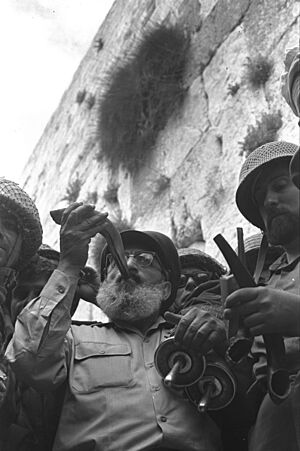
East Jerusalem was captured by the Israel Defense Forces on June 7, 1967, during the Six-Day War. Most Jews celebrated this as a liberation of the city. A new Israeli holiday, Jerusalem Day, was created. The Western Wall became a major site for national ceremonies and prayers.
After 1967, people of all religions were generally allowed access to their holy sites. However, there have been some restrictions, especially for Arabs from the West Bank and Gaza. Jewish prayer on the Temple Mount is prohibited by both Israeli and Islamic authorities.
The status of East Jerusalem remains a very controversial issue. The international community does not recognize Israel's annexation of East Jerusalem. Most countries keep their embassies in Tel Aviv, though some, like the United States, have moved theirs to Jerusalem. The United Nations Security Council Resolution 478 declared Israel's 1980 "Jerusalem Law" (which declared Jerusalem Israel's "eternal and indivisible" capital) to be "null and void."
Since 1967, some Jewish organizations have worked to establish a Jewish presence in East Jerusalem neighborhoods like Silwan. This has led to ongoing disputes over land and property.
Images for kids
-
The Hereford Mapa Mundi, a medieval map, shows Jerusalem at the center of the world.
-
Jaffa Gate in Jerusalem during 1944 British demolition of recent construction.
-
A silver coin from the Bar Kokhba Revolt, showing the Jewish Temple facade and the words "To the freedom of Jerusalem."


